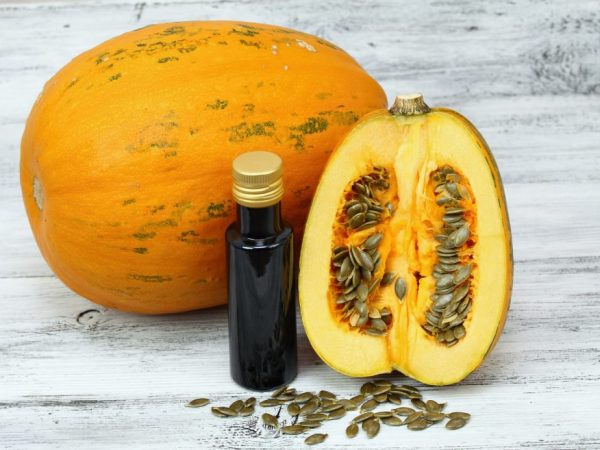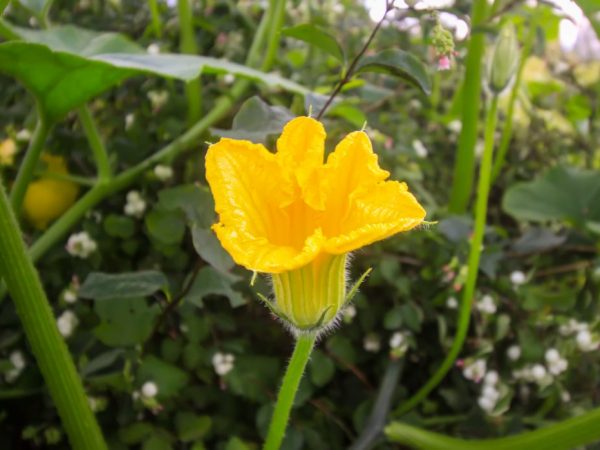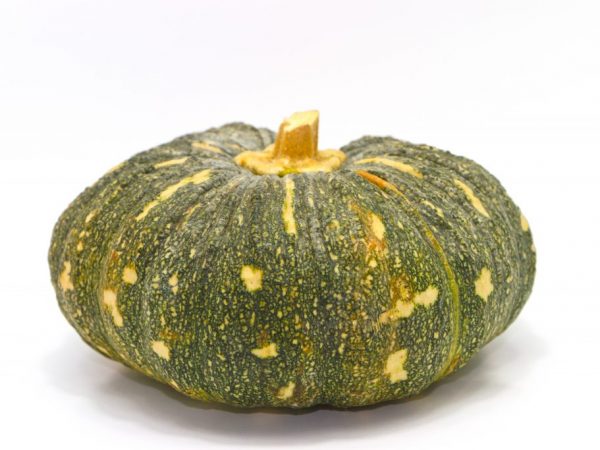Growing gymnospermous pumpkin
Gymnospermous pumpkin occupies a special place among the varieties of the family of this culture. The peculiarity of the vegetable lies in the uniqueness of its seeds. The common people call the pumpkin the Queen of Autumn - its benefits for humans are undeniable. It is used in cooking, folk medicine, and cosmetology.

Growing gymnospermous pumpkin
Species characteristic
Pumpkin of this species is a large plant with liana-shaped hollow stems that can reach a length of 12 m. Its root system is powerful, the process of growth and development is rapid.
The flowers of the culture are large. The fruits are medium in size (weight - 5-8 kg), covered with a thin hard crust. The pumpkin needs the necessary moisture level for it, especially the period when the vegetable forms the ovary. Delay in watering leads to a decrease in the size of the fruits, they lose their attractive appearance.
Beneficial features
Most of the representatives of gymnospermous pumpkin belong to technical varieties, which are intended for obtaining oil from the seeds of the culture. Were bred crops, the pulp of which is characterized by a high level of sugar and a large amount of nutrients contained in the vegetable.
The peculiarity of such a pumpkin is its seeds, which are completely devoid of the usual hard peel. Their application is extremely wide:
- they are used to produce high quality oil;
- dried and crushed seeds are a useful addition to many dishes;
- they are often used in traditional medicine.
The content of vitamins E and A in pumpkin seeds, which act as antioxidants, characterizes them as an excellent remedy for rejuvenation.
Growing features
According to the description of the gymnospermous pumpkin, it is thermophilic. This factor affects the agricultural technology of this crop.
Requirements for soil and crop rotation
A place for planting a culture should be chosen sunny, protected from gusts of wind and drafts. The ideal option is the southern slopes of the hills.
A well-developed root system of the fruit requires a nutritious, well-fertilized soil. One of the main conditions for growing such a pumpkin is that the soil should not be acidic. In this case, before planting a crop, this indicator must be returned to normal.
To get a good harvest of high-quality fruits, gymnosperms must be systematically fed with both organic and mineral fertilizers.
Crop rotation is of great importance when planting pumpkin. It is not recommended to plant the culture and other members of its family (cucumbers, zucchini, squash) in the same place for the second year in a row. This is explained by the following reasons:
- pathogens of diseases that are characteristic of all members of the pumpkin family may remain in the soil;
- the land after these crops is depleted, it takes some time to recover, it will not be possible to grow a vegetable on it and get a rich harvest.
Good "predecessors" for pumpkin can be potatoes, beets, carrots, spicy herbs, etc.
The risk of over-pollination

Pollination will harm the plant
Growing a gymnospermous pumpkin is laborious. Pollination of plants occurs with the help of insects. If there are other varieties of the pumpkin family near the crop area, the risk of cross-pollination increases significantly.
It will manifest itself in the fact that next year the seeds of the culture will be the same as those of an ordinary pumpkin, i.e. will have a peel.
For greater confidence that this particular type of pumpkin will grow on the site next year, and not its hybrids, gardeners are trying to do pollination on their own. The essence of this process is that the pollen from the male flowers is collected on a brush and carefully placed on the female inflorescence.
It is recommended to do this several times. After pollination, the flower should be isolated (with polyethylene, rubber bands, etc.) so that insects do not cross-pollinate, thereby harming the plant.
Agricultural rules
Seeds that will be used for sowing next year must be selected from healthy, fully ripe fruits. After collection, they are washed, dried and placed in paper bags.
Before planting, the seeds are soaked for several days in water, and after the first shoots of the future root system appear, they are planted in the ground. An important condition for this pumpkin is a well-warmed, moderately moist fertile soil.
If planting is done directly in open areas, the soil under it should be fertilized. This is done as follows:
- we form a hole with a diameter of 30 cm, into which we pour 1.5-2 liters of water (always warm);
- put 5 kg of humus, 70 g of superphosphate fertilizer and 250 g of wood ash into the recess. We mix all the components with the soil at a depth of 20 cm;
- in the resulting substrate with a distance of a couple of centimeters, place several pumpkin seeds (3-4) to a depth of 5 cm. After germination, select the 2 strongest sprouts, remove the rest;
- fill the hole with soil and mulch.
It is advised to plant gymnospermous pumpkin by seedling method. This not only increases the yield of the crop, but also eliminates the need for its later planting.
An important nuance when placing seeds for seedlings is the correct timing for transferring seedlings to open soil. 21-28 days should pass from the moment the seedlings hatch until they are moved to the beds, the height of the seedling should reach 20-25 cm, and it should have at least 2 leaves.
Transplanting can be carried out almost painlessly for the crop using special peat pots.
Pumpkin selection

A dry tail indicates the degree of ripeness of the fruit.
When choosing a culture, you should pay attention to the following nuances:
- a ripe pumpkin has a dry tail;
- the vegetable should be of medium size. This indicates the absence of excessive fiber;
- it is generally accepted that the brighter the color of the fruit, the sweeter its pulp;
- the fact that the pumpkin is gymnospermous mature is evidenced by a dull sound that occurs when tapping on it;
- the peel of the vegetable should be even, smooth, without rotting and other damage.
Gymnospermous pumpkin varieties
The main feature of such a pumpkin is its seeds - without a peel, covered with a transparent edible film, which contains a large amount of fiber. The pulp of the fruit is characterized as juicy, spicy-sweet and extremely rich in nutrients.
Golosemyanka
Thanks to this variety, gardeners learned about the presence of a culture with unique "naked" seeds.
The pumpkin is an abundantly branched plant with stems reaching a length of 5 m, which is characterized by medium climbing.The final ripening of the fruits occurs 110-115 days after planting. From one plant, under favorable conditions, you can collect up to 15 kg of fruits.
The average weight of one vegetable is 3-4 kg, the shape is flattened, the pulp does not taste particularly sweet.
Pumpkin Golosemyanka is distinguished by its comparative resistance to low temperatures.
Olga
Varietal pumpkin Olga favorably stands out among others in that its seeds are often used for the production of pumpkin oil.
It is characterized by mid-maturity and medium climbing. The fruits are round in shape, the weight of one specimen is 5-6 kg.
Characteristics of the fruit: pumpkin pulp has a light shade, slightly sweetish. Large seeds.
Danae
Full maturation occurs 120 days after planting. Description of the vegetable: the fruits are round, medium in size. Pumpkin pulp Danae is light yellow, dense, crispy. Differs in a high level of sugar content and starchiness.
The culture belongs to the strong-leaved varieties. Sensitive to over-pollination.
Miranda

The fruits have a juicy pulp
The homeland of this variety of gymnospermous pumpkin is Poland. A characteristic feature of the culture is the way it grows - it belongs to the semi-shrub plants. This makes it possible to plant it in small areas.
The Miranda variety is mid-season, the fruits are light green in color, have a slightly flattened shape. The pulp is juicy, medium sugar.
Styrian
This pumpkin is very popular with gardeners. In its homeland, in the Austrian city of Styria, this variety is used to a large extent for the manufacture of oil, which has a zesty nutty flavor and aroma.
The variety is mid-season, long-flowered. The fruit weighs 4-8 kg. The shelf life can be up to 3 months.
Apricot
At one time, this pumpkin was popular. Due to the fact that its taste resembles an apricot, juice was even made from the fruit, which was sold under the guise of fruit juice.
Description of pumpkin Apricot: the vegetable belongs to early ripening, dessert varieties, the shape of the fruit is oval, the pulp is light yellow.
Juno
Juno pumpkin belongs to the early maturing varieties. The plant is characterized by abundant climbing. When growing, it is imperative to observe spatial isolation.
Description of fruits: the vegetable has a round shape, weighs about 4 kg, the pulp has a very pleasant aftertaste. Juno pumpkin is used fresh and processed.
The fruits can retain their qualities for 4-5 months.
Harvesting and storage
Harvesting of the pumpkin begins when the fruit reaches its biological ripeness. It is recommended to carry out cleaning in one day, it must be done before the onset of frost.
If gymnospermous pumpkin contains more moisture than it should be, it should lie in the windrows, where its final ripening takes place.
The collection of vegetables on an industrial scale is carried out using special pumpkin harvesters. With their help, seeds are also extracted from the fruit, which are then subjected to processing (washing, drying).
For further storage, the fruits are washed from the ground, dried and placed in dark, cool, ventilated rooms (cellar). The average shelf life of a pumpkin is 2-3 months.
Vegetables are placed with their stalks upward in special wooden trays, on shelves or in racks. In this case, the fruits should not touch - you need to transfer them with hay. Pumpkins with obvious damage are not suitable for storage.
Gardeners reviews
Gardeners point out that one of the difficulties of growing pumpkin is its thermophilicity. Inconvenience is also caused by the need to isolate it from "relatives".
According to the observations of gardeners, such a relationship has been revealed: the longer the stalk of a vegetable, the longer it can be stored.
The positive properties of pumpkin contribute to the fact that both experienced gardeners and amateurs continue to grow it massively on their plots.

